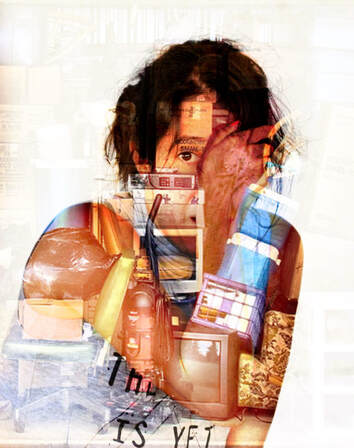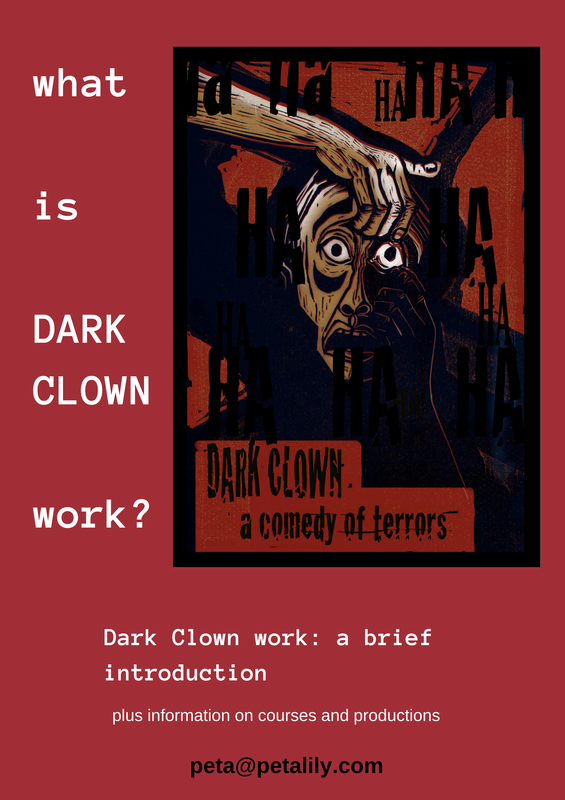 The existential burden of Things - photo Robert Piwko, collage Peta Lily
The existential burden of Things - photo Robert Piwko, collage Peta Lily To prepare for this exercise, there are two steps.
First in full group I give a short demonstration of me talking about a happy day, but while sobbing. ‘Choose a happy moment, a real one – no you don't have to choose a moment that is very precious, just a nice simple happy day.'
The group pair up and take it in turns to do this task.
After each turn there is usually a lot of laughter. Most people can remember an instance of crying in childhood and at some level enjoying the rhythms of one’s own demonstration of injustice. Not that the laughter is about any kind of insight, it is mostly just a response to a release of energy, or the fun to be had in being given permission for rhythmic vocal play.
List your possessions
Step two. Find a new pair partner. (I find it advantageous to keep the energy circulating in the room).
This time, the first one to try the exercise will list their possessions, just as they come to mind, actual possessions, starting with something small. Each thing named needs a small piece of mime or gesture and the object needs to be created and or placed somewhere specific in the air around the performer, i.e. to the or right or left, higher or lower. For example: a pencil could be held up vertically, or measured between two forefingers; hands could make four quick tiers for 'towels'; a pillow could be held in two curved hands and given a little shake. People can use pantomime blanche, where a rectangle drawn with forefingers can represent a TV. Or it can be quick mime i.e. typing fingers on a keyboard for laptop. Each time each object is mentioned, the accompanying gesture needs to be in the exact same place.
Their partner’s role is to put pressure on them, hector them (to help create a sense of High Stakes), asking 'What else?', ''What else have you got?', and once there are a few things, the partner will shout 'LIST!" - and the do-er of the exercise must list in exact order each thing they mentioned complete with the exact gesture and location in space. Of course any mistakes are to be welcomed. If there is brain freeze, the perfomer can make a sound to voice their anxiety. Dark Clown work represents the Marginalised Emotions. Any dithering or tongue trip can be voiced. If they can't remember the list or get something out of order – great! The doer can feel the embarrassment or other emotion of the wrong gesture or wrong order and to express that with inflection of voice, breath and/or gesture.
Swap - the other partner lists and the first do-er hectors.
The Consumer Guilt Scenario – basic setup
Now – the Consumer Guilt Scenario. The group line up chairs ready to sit and watch as audience. This is a solo piece. I ask who is willing to be the first player and I add more information: 'Imagine that you are standing before some kind of Tribunal (think of ‘self-criticism’ in the Stalinist era, or a less violent version of a ‘struggle session’ during the Cultural Revolution in China).'
The player needs to invest in something at stake – even if it’s at a simple level of nervousness and uncertainty as usual in any panel interview: 'What will the outcome of this interview be? How many items must I list? Is my list long enough? Is my list too long?'
Remember, Dark Clown uses a High Stakes to release the impulses for Marginalised Emotions. I play my part in offering stimulus to raise the stakes.
Transparent teaching
I let the group know that when I raise my voice or speak harshly, that I am taking on the role of a power figure. The player of the moment is invited to pretend in the proposed predicament as well as they can, knowing that they also need to avail themselves of any moments of naturally arising impulses and to give them shape and sound. The work on the course leading up to this exercise lays a lot of ground work, so course participants know what the methodology is and why things are happening. They have also had a preparatory talk laying out the aims and ethos of the work.
When I give a sharp command, the aim is to startle the physiology – most people’s intonation will rise when given a sharp instruction, some people stutter (these form part of the rhythms and timbres we play with as 'Dark Side Play'). Those who have worked with Gaulier or a Gaulier-trainer Clown teacher, will know that the teacher's interventions in role as grumpy Clown Professor are there to give the (Red Nose) Clown a skip in their step, or to release an emotion (the Red Nose Clown’s unmasked humanity which we love to see), or to allow the Clown to release some élan, to ‘save the furniture’ (save the situation).
As stakes-raiser, I say, or shout ‘What have you got?’ And they are off.
I switch to my coaching voice to remind them to give clarity and simple precision to each item they mention.
The mechanics of responding to the audience within the Predicament
From the start of the course, I have been encouraging the participant to look and see (‘when you look, remember to see’). The other way I phrase this is to emphasise ‘noticing’. Each audience reaction can feed the performance of the player.
The performer needs to work the audience as a comedy player needs to work / respond to an audience, while in their imagination, they see and respond to the audience as the panel.
If the audience laugh, it is useful to imagine that perhaps they did not understand, perhaps some of the ‘panel’* don’t speak your language - this gives the opportunity for the player to repeat it (exact timbre, rhythm, volume, using proprioception) you say it again (usually another laugh occurs) - the player can then allow this to unnerve them and therefore take the opportunity of a further repetition (as if due to nerves), and say the thing a third time (usually someone else in the row of watchers/class audience with laugh then Rule of Three). Then the player can react with anxiety to the fact that they are being laughed at. This serves two purposes: a/ the logic of the predicament - 'is laughter a good or a bad thing?' serving the stakes and performed emotional state of the player and b/ the comedy craft - 'laughter an interruption that must be dealt with’ as Avner the Eccentric says.
What, in this moment, does the interruption do to the figure in the improvised predicament? Does it put them off their game, shame them?
Ongoingly, there is the pressure to keep more items coming, and of course to ramp up the rhythm by responding to the command: ‘LIST!!’
Raising the stakes again - the importance of imaginative investment
Ok – let’s go back to the set up for the exercise – because there are a couple more elements to it.
The name of the scenario is Consumer Guilt. I remind the player of the moment that they can begin the improvisation crying or they can work the items / list game first, then do the list citing or break out into sobbing as a counterpoint / contrast / escalation. I remind the player where necessary to avail themselves of different rhythms and timbres.**
Combined with this, I invite us all to reflect on our privileged lives and the obscenity of what we own in comparison with many in the world.
To activate this further - one more thing is set up. I mention the ghastly earthquake in Haiti, and invite the player to see, over to the left (metaphorically, In their minds eye) – a little grandma - to imagine a poor little aged woman who has lost everything … every thing … I say. She is there, naked, under a piece of plastic supported on sticks, next to running sewage.
'Ok now – what have you got?'
Every so often, if people are not allowing the emotions of guilt and shame to surface, I prompt them to look at Grandma.
And to say: ‘I’m sorry Grandma.’ And to say it: 'Again!'
If needed, I invite them: ‘can you sob a bit?’
'List!! What else have you got?! Look at Grandma, say: "Sorry Grandma."'
If people can segue into sobbing, a further level yet can be added where they look up, appalled at themselves and say ‘oh god!’ and play with what timbres and rhythms of that game - or use 'oh god' as punctuation / counterpoint / alternation with the game of listed objects interrupted by the apologies to Grandma.
Trouble shooting - noticing and sounding the arising emotions
People can, understandably enough, focus on coming up with the next item. There is zero need to come up with anything interesting, there banal the better. People tend to be task-oriented rather than being-oriented. What's key in clowning in general is noticing, accepting and including any passing emotion that may arise. While the list is necessary and important to get a rhythm going (as well as provide the content for the contrast, the obscenity of plenty and the picture of inequality), what we really enjoy are the little flinches, the flecks of pain that read in the eyes of the player who is immersing into the pretended (but heck let’s face it fully grounded in reality) Predicament. Any anxiety about a delay in finding the next item, or fear of not being able to think, or nerves about standing in front of other - all these are impulses to be experienced. All Clown students would do well to allow themselves to express the micro-emotion of the moment in sound and movement. Wonderful, strange, little quirks can affect the face or the voice under even a modicum of stress.
Resistance and the accidental extraordinary physiological response
People sometimes resist looking at Grandma. (Thereby cheating themselves of the opportunity to escalate their playing energy).
Working in Holland in January***, despite several reminders ‘Look at her!!’, the player was resisting doing that.
‘Look at her!!!!’, I insisted, and she did start to turn her head ... but before her neck fully turned, it snapped back. It was this wonderful, compelling, unplanned flinch of aversion!
We laugh with delight or incredulity or just plain surprise when the Red Nose Clown does a spontaneous something that is quirky and fresh-minted from the impulse of the moment.
For me – that involuntary flinch was a similar gem - eliciting a gasp of Troubled Laughter.
These unbidden gestures (accidents of the moment and of physiology) are the nuggets of the joy / pain / catharsis of the Dark Clown. The wonderful performer who plays The Seal in the ‘Eco Horror’ scenario shown in the Dark Clown documentary (Hospital Clown Faith Tingle) has done the Clown & Dark Clown course three times. She surrenders her physiology to the imagination and the impulse of the moment. In Dark Clown the impulse can be an ongoing (pretended) stress situation. Once, doing the ‘Horror Is’ exercise, she invested magnificently in imagining her phobia/object of dread and her forehead veins bulged and danced in a compelling way. And because her rhythms were in place, laughter was released. A sound could be made in a moment of witnessing stress – cathartic nugget.
Let's go back to the player in Holland and that wonderful flinch! What we saw in that moment was a human who would not look. Her very body resisted the direct command. It was such a human response – we all know in ourselves that knee-jerk will, that aversion, that refusal to look at pain - those moments when we really do not want to look on hurt or ugliness, when we want to live our lives as we have arranged them, not accept responsibility for others, and not have our status quo threatened. Arrogance and fear mixed – how is that for a Marginalised Emotion! And I love it all the more because it is not coming from reason, it's coming from the body's primal instincts, the Amygdala response (if talking about the Amygdala in that way is still good science).
Shame - another memorable moment
In December 2019, there was a wonderful iteration of this exercise. The player of the moment was a talented actor and dancer.
In his list of possessions, he mentioned shower gel and a loofah. Something about this, about the way he said it, had a quality that attracted my attention. He is an intelligent person and was no doubt alert to the particular combination of privilege to be able to afford the healthy natural and rather exotic product (the obscenity of owning items which invest us with a touch of smugness) and also the vanity of it too - like the Beckhams, we exfoliate.
I said, 'Ok you are going to take that loofah and that shower gel and have a shower, and apologise to Grandma while it is happening' (Just so you know - I have a rule that course participants can choose to break and leave an improvisation if they so wish at any moment of their choosing). He took the invitation / provocation and began to shower (fully clothed, just to be clear!) and he did something I did not expect. He remained in relationship with (aware of) Grandma as he started to come showering, and then there was this little instinctual shift of his body and he turned the front of his body away from her. We saw a human being ashamed to have the luxury Grandma did not, ashamed to affront Grandma with his nakedness, and also ashamed on his own account of being naked in front of Grandma. So poignant, so ghastly. I am no stranger to the emotion of shame and it is so – I don’t know the word … liberating, reassuring, the opposite of alienating? Validating? Healing? Thank heavens for Brené Brown doing her risk-taking work in the field of Shame. To be able to see these awful moments of life in a ‘safe’ setting in the ritual space of theatre or theatre making or theatre training.
*To be clear, the player looks at and is tasked with reading the audience as 'panel' (while attending to their laughter and other responses according to the techniques of comedy craft, as audience). The audience when watching exercises or scenario improv’s are instructed to be a normal audience. When I say panel – this is the reality of the predicament of the performer. The performer is playing someone standing before a panel. The performer responds to the laughter and silences of the audience from within the pretended predicament. Occasionally one needs to coach participants sitting in audience (either in Red Nose or in Dark Clown exercises) to avoid the impulse to coach fellow course members - i.e. to call things out to them that you think they should do. The work at hand is training how to work a normal audience. If people are calling out as peers/would be coaches, how is that helping their fellows train to work a normal audience?
**When we do a very early Red Nose Clown exercise ‘Moving Around the Room Like’, I land this point: ‘Clowning is not intellectual. It is often a shape, phrase, sound timbre rhythm that we like … so much that we’d be happy to see it again … and again (the Peekaboo exercise reinforces this, so does the example of playing with a baby ‘LookatthePanda ….’). We see how laughter can wane or fail if people have not built sufficient proprioception skill to accurately reproduce the thing that happened just before the laugh. If they do it softer volume it’s a disappointment and can remove the possibility of a rule of three; if they forget what they did, tumbleweeds may ensue.
***'Comedy can make people aware of what is going on in a way that is easier to digest than the news. It engages people more. I got what I came for and I a lot more fun, playfulness and laughter than I expected, given the subjects are ‘dark’. What surprised me though, was how very alive I felt after the weekend with the Dark Clown.' - Course Participant Jan 2020 Utrecht

 RSS Feed
RSS Feed
